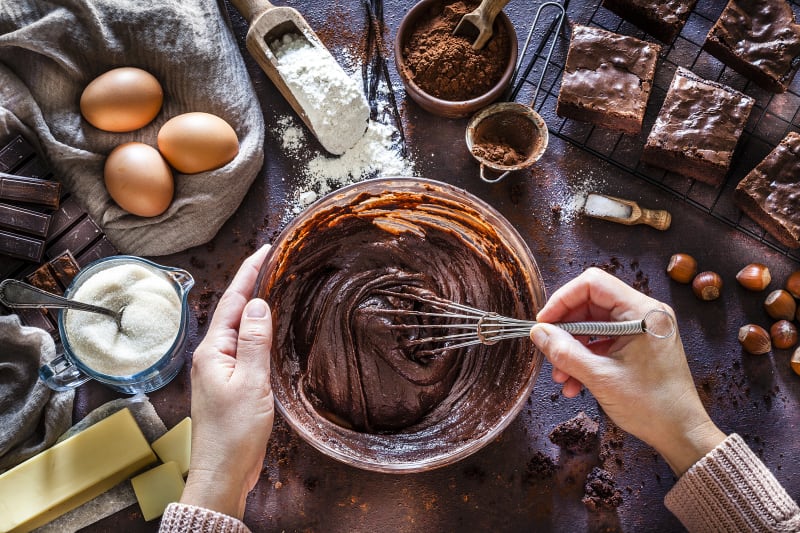You are using an outdated browser. Please upgrade your browser to improve your experience and security.
Chocolate brownies
Contents :
Brownies are a type of chocolate cake from the United States that often include nuts. Their very simple recipe can be adapted to all tastes with a few extra ingredients or an original accompaniment. Whether you like them cooked through, melting in the middle or somewhere in between, you need to bake them just the right way! Read our recipe for Valrhona chocolate brownies and some accompaniment ideas.

Chocolate brownie recipe
Our chefs have developed a delicious Valrhona chocolate brownie recipe. The preparation is quite simple, but baking requires some vigilance. The recipe allows you to make a 1500 to 2500g cake that you can cut into individual portions.
Valrhona brownie ingredients
To make a Valrhona chocolate brownie at home or in a professional kitchen, you will need:
- 410g brown sugar
- 290g whole eggs
- 360g European dry butter (84% or 82% fat)
- 200g dark chocolate drops
- 170g plain flour
- 120g white almonds
- 120g green pistachios
- 120g pecans
- 360g dark chocolate chips
We recommend using Valrhona Extra Amer 67% or Extra Noir 53% couverture chocolate and our 52% Dark Chocolate Chips.
For a softer brownie, you can replace the dry butter with 288g of clarified liquid butter (80g of clarified liquid butter replaces 100g of dry butter).

Preparing the nuts
Before you prepare your brownie mix, you will have to roast and then crush your almonds, pistachios and pecans.
- Heat your oven to 285/300°F (140/150°C) (gas mark 5).
- Remove the baking tray from the oven and cover it with a sheet of greaseproof paper, then lay out the nuts on top.
- Bake the nuts for 10-20 minutes to roast them.
- Move them around from time to time so they roast evenly.
- Remove the nuts from the oven and place them on a chopping board.
- Allow them to cool down a little to avoid burning yourself.
- Crush or roughly chop the nuts.
By proceeding in this order, you won’t roast small pieces that might burn.
Preparing the brownie mix
Now let’s move on to your brownie mix. First, melt the butter and chocolate, then add the remaining ingredients in a precise order.
- Start by melting the butter and chocolate together in a bain-marie. Aim for a temperature of 100/120°F (45/50°C).
- Briefly mix together the brown sugar and eggs.
- Add the melted butter and chocolate mixture to the brown sugar and egg mixture.
- Sift the flour.
- Add the sifted flour, the ground and roasted nuts and, finally, the chocolate chips.
Baking the brownies
Baking is the most important part of preparing your brownies. To get it right, you have to choose the right temperature and stop baking at the right time depending on your mold and your preferred result.
Mold or frame
To bake your brownie, choose either a mold or a square or rectangular frame. Our chefs recommend a size of 40 x 60cm.
If you use another size, remember to adapt the temperature and baking time to the thickness of your cake. With a smaller size, your brownie will be thicker and therefore need to bake for longer, but at a lower temperature.
Temperature and baking time
The baking temperature depends not only on the mold, but also on the oven you use:
- In a convection oven, you should bake your brownie at 320/355°F (160/180°C).
- In a deck oven, the recommended temperature is 355/390°F (180/200°C).
The baking time depends on the result you want to achieve. For example, you will need to take melt-in-the-middle brownies out of the oven before they look ready. Because the brownie retains its heat for a while, it will continue to cook. Bake for 20 to 25 minutes depending on the thickness of your mix and the desired result.
Instructions
- Preheat your oven to your chosen temperature.
- Grease your mold and coat it with flour.
- Place it on a baking tray covered with baking paper.
- Pour your brownie mix into it.
- Bake your brownies.
- Take them out when they reach your desired consistency.
You can use a knife to check how cooked through they are, but don’t wait until the knife comes out dry. It’s perfectly normal for brownie to look soft, sticky or even liquid, as it will take on its final consistency as it cools.
Accompaniments for your brownie
You can also personalize this recipe when you serve your brownie. There are lots of different accompaniments that will allow you to vary your brownies’ flavors, temperatures and textures.
Creams
Brownies are often served with custard or whipped cream. If you want to stick to these classics, why not add an original touch by flavoring them?
For example, you can infuse your custard (which is traditionally vanilla-flavored) with cinnamon, orange or pistachio. As for whipped cream, you can add coffee or raspberry flavors.
Coulis, toppings and sauces
Similarly, you can prepare a fruit coulis, a glaze to cover your brownie, or a sauce served hot or cold.
Consider, for example, a mango or raspberry coulis, a chocolate topping (made with the same or a different type of chocolate), salted butter caramel sauce and so on.
Ice creams & sorbets
Brownies are often served warm, with a scoop of vanilla ice cream. Again, you can stay true to this tradition without limiting yourself to one flavor.
You can opt for pistachio ice cream or coconut sorbet to bring out your brownie’s nutty flavor. Alternatively, try something different with a beetroot or apricot sorbet, which go very well with dark chocolate.
Of course, there’s nothing to stop you combining these accompaniments. For example, a scoop of vanilla ice cream with salted butter caramel sauce is a guaranteed hit. On the other hand, pistachio custard with raspberry coulis is bound to amaze people.